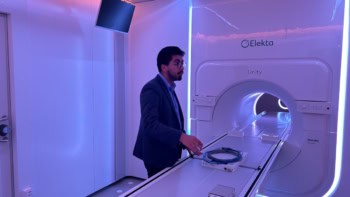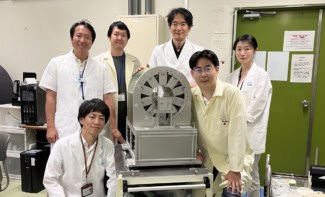
Boron neutron capture therapy (BNCT) delivers targeted radiation directly into tumour cells, with minimal damage to healthy tissue. It offers the potential to treat micrometastases that can’t be visualized on medical images and typically requires just one or two treatment sessions. So why is BNCT not yet a mainstream cancer treatment?
The main obstacle is that, historically, BNCT required a nuclear reactor to generate the neutron beams needed for treatments. To overcome this problem, California-based TAE Life Sciences is developing an accelerator-based neutron source. “We have created a low-energy neutron beam source that is reliable, compact and can be installed in a hospital facility,” says Bruce Bauer, CEO of TAE Life Sciences. “This changes the game on BNCT.”
BNCT is a two-step treatment. First, the patient is given a drug that contains boron-10 and preferentially targets cancer cells. The drug is non-toxic and has no effect on its own. The most prevalent targeting drug is boronophenylalanine (BPA), which is taken up by highly metabolic cells and accumulates roughly 3.5 times more in cancer cells than in normal cells.

Next, the tumour region is irradiated with a low-energy neutron beam, which also causes little impact on tissue by itself. When the neutrons impact the boron atoms, however, this causes a fission reaction that creates two alpha particles. These high-linear-energy-transfer particles cause double-strand breaks within the cell, with about three times the relative biological effectiveness of photon or proton irradiation.
“This is cellular targeted particle therapy, where the cytotoxic radiation is generated by secondary reactions inside the cell,” Bauer explains. “The benefits are that it delivers far more lethal damage and the damage is limited to just that cell.”
Early promise
Around 2000 patients have been treated with BNCT over the last couple of decades, until recently, using nuclear reactors as the neutron source. “The results were encouraging enough to keep the research efforts alive,” says Bauer. “But everyone said that this will only have a future once you can generate neutrons in a hospital facility.”
TAE Life Sciences’ neutron generator is a product of 20 years of research and development by its parent company TAE Technologies, a specialist in fusion energy technology. “Our accelerator has a unique design, it is a component of their fusion reactor, downsized to create an accelerator that’s well suited for medical use,” says Bauer. He notes that the system can be installed in a single room and requires less than 1 m of shielding.
The accelerator also benefits from generating an ideal energy spectrum for BNCT: 1–30 keV neutrons. Lower energies can lead to surface damage, while higher energies cause more damage while traversing tissue. TAE Life Sciences’ beam has very few neutrons on either side of that spectrum, minimizing side-effects from the neutron beam.
Bauer notes that a few other companies are also creating accelerator-based neutron sources, including Sumitomo, which is developing a cyclotron, and Massachusetts-based Neutron Therapeutics, which last month installed its accelerator-based BNCT system at the University of Helsinki. “The first wave of these systems are now being installed in clinics,” he says, noting that Japan is pioneering this treatment with over six BNCT programmes underway. “Over the next two years we will see more of these systems being installed.”
Clinical transition
Because it enables cellular targeting, BNCT is ideally placed to treat complex targets, such as tumours that infiltrate normal tissue or are near critical structures, as well as radioresistant and recurrent tumours. And for large head-and-neck tumours, BNCT provides better cosmetic outcomes and less scarring than surgery or standard radiotherapy.
“BNCT lends itself well to cancers that are difficult to map and treat by other means,” says Bauer. “It has been shown to be very well tolerated, with negative side effects substantially less than other treatments. This gives another option to the oncologists.” It is also more convenient for the patient, as only one or two treatment fractions are required and less immobilization is needed than with conventional radiotherapy.
The targeting drugs used to deliver boron-10 are also under continual development. And as better drugs become available, this will enable treatment of more diseases, such as glioblastoma, for example, where early studies have shown promise. Once proven, BNCT could be employed to treat a broader range of cancers, such as liver, lung and breast tumours
“The first-generation data are encouraging, we need to show that we can optimize the neutron source and understand the dosimetry in order to treat larger cohorts of patients,” Bauer tells Physics World. “We want BNCT to be part of the cancer treatment arsenal, complementing existing treatments and eventually as its own modality.”
TAE Life Sciences will install its first BNCT system later this year in China, with the first patient treatment aimed for next year.



